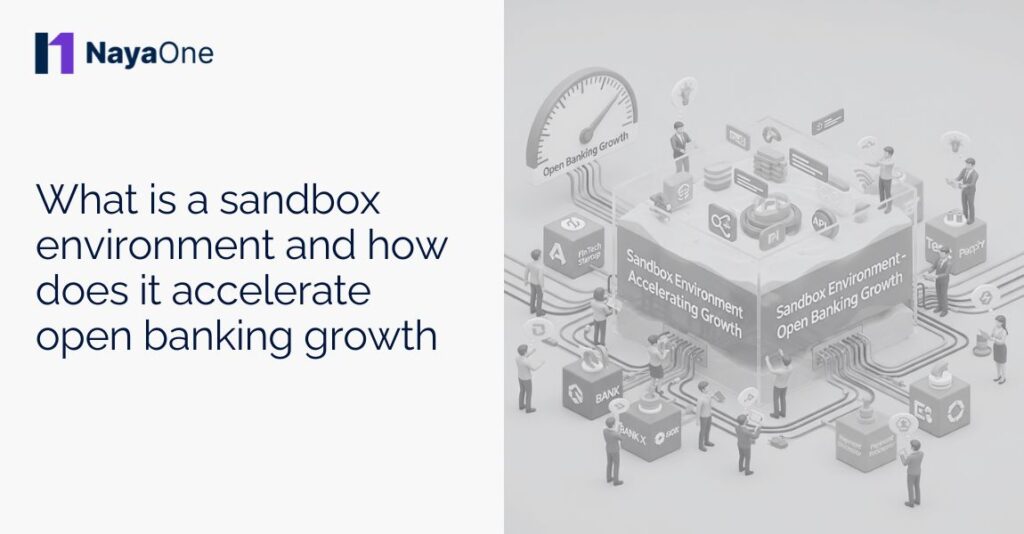When banks and fintechs want to test new ideas, the first question often is: what is a sandbox environment? Simply put, it is a secure, isolated digital space where organisations can trial new APIs, financial products, or services without putting real customer data or systems at risk.
A sandbox environment is particularly valuable in open banking, where multiple parties, including banks, fintechs, and third-party providers, collaborate and share data. It allows innovation to happen quickly and safely. Teams can validate concepts, troubleshoot integrations, and ensure compliance without disrupting live services. In fact, according to Grand View Research, the global open banking market is expected to grow at a compound annual growth rate of 27.6% between 2025 and 2030, reaching approximately USD 135.17 billion by 2030. This rapid growth highlights why understanding what is a sandbox environment, is essential for financial institutions looking to innovate confidently.
What is a sandbox environment?
A sandbox environment is a secure, isolated testing space that mimics real-world systems. It allows developers to run code, test APIs, or simulate transactions without touching live data. Imagine it as a rehearsal stage where apps and services can be tested safely before facing the audience.
In open banking, sandboxes are crucial because they enable third-party developers to experiment with bank APIs without affecting customers’ accounts or sensitive information. For example, a fintech startup could test a new payment solution in a sandbox, validate its functionality, and ensure it complies with regulations before rolling it out commercially.
Regulators often encourage sandbox environments as well. Many countries provide “regulatory sandboxes” where innovators can test new services under supervision, reducing risk while still fostering experimentation. This controlled environment strikes a balance between creativity and compliance, which is essential in finance.
How does a sandbox environment accelerate software testing and integration?
What is a sandbox environment? In financial systems, testing can be slow and complicated. A sandbox environment provides a safe space for teams to identify bugs, test new APIs, and validate workflows in realistic conditions, all without affecting live services. Developers can experiment, learn from mistakes, and iterate freely without worrying about disruptions.
One key advantage is faster integration. Open banking relies on multiple parties sharing APIs and data. Sandboxes let developers check how these connections work in practice, resolve conflicts early, and reduce the risk of errors during live deployment.
Another benefit is repeatability. Developers can reset the environment after each test, try new configurations, and monitor performance. Many sandbox environments also include analytics tools to track how applications behave, helping teams optimise their solutions before release.
Why is a sandbox environment important for open banking growth?
Open banking is all about collaboration and innovation. Banks, fintechs, and third-party providers need a way to work together safely. Understanding what is a sandbox environment helps explain how these organisations can test new ideas without risking customer trust.
It encourages faster product development and innovation. Fintechs can experiment with features like account aggregation, payments, or AI-powered financial tools. Banks can explore partnerships and test new services without disrupting existing operations.
Sandbox environments also help with regulatory compliance. By simulating transactions and workflows under controlled conditions, organisations can ensure that new products meet the required legal and security standards before going live. This reduces the risk of costly mistakes and builds confidence among customers and regulators alike.
Finally, sandbox environments foster a culture of experimentation. Teams can explore bold concepts, validate business models, and learn what works best, all in a structured and monitored environment. For open banking, this means faster innovation, smoother integrations, and ultimately better services for customers.
How do organisations implement a sandbox environment?
Setting up a sandbox environment might seem complex, but it can be straightforward if approached methodically. Here are the key steps:
- Define objectives: Identify what you want to test, whether it’s APIs, payment flows, or new products. Clear goals help guide the design of the sandbox.
- Select the platform: Choose a sandbox solution that matches your technical requirements. Look for scalability, security, and integration features.
- Configure access control: Ensure that only authorised users can enter the sandbox and define what actions they can perform. This maintains security and prevents accidental misuse.
- Set up monitoring: Track activity, errors, and performance within the sandbox. Analytics help teams understand outcomes and optimise processes.
- Integrate with workflows: Connect the sandbox with development and testing pipelines to streamline collaboration and speed up testing cycles.
A well-implemented sandbox environment not only supports testing but also encourages experimentation, helping teams innovate confidently while reducing operational and regulatory risks. According to a report by Growth Market Reports, the global Partner Sandbox for Open Banking market size reached USD 1.43 billion in 2024, reflecting robust momentum driven by digital transformation in the financial sector. The market is set to expand at a compound annual growth rate (CAGR) of 21.7% from 2025 to 2033, with the forecasted value anticipated to reach USD 10.43 billion by 2033.
This significant growth underscores the increasing reliance on sandbox environments as essential tools for fostering innovation and ensuring compliance in the rapidly evolving open banking landscape.
Can a sandbox environment truly drive open banking growth?
Yes. A digital sandbox environment is more than just a testing tool. It is a catalyst for innovation, allowing banks and fintechs to experiment, validate, and refine ideas in a controlled, secure environment.
By providing a safe space for experimentation, sandboxes accelerate open banking growth. They help developers test new APIs, explore partnerships, and ensure compliance, all without putting real systems or data at risk.
Knowing what a sandbox environment is helps businesses see why this tool is essential for innovating while staying secure and compliant. It changes the way organizations approach testing, integration, and product development, leading to faster innovation and better services for customers.
FAQs
Accordion Content
No, a sandbox environment cannot replace live banking systems. Instead, it complements them by providing a secure, isolated space for testing and experimentation. Teams can safely trial new APIs, payment flows, or financial products without risking customer data or operational disruptions. This setup ensures that any issues are caught early, reducing costly mistakes and maintaining trust in live systems.
Sandbox environments are particularly valuable for banks, fintechs, and third-party providers that need to innovate quickly while remaining compliant with regulations. Developers, product teams, and compliance officers all gain from the ability to test ideas, explore partnerships, and optimise workflows in a controlled environment. Ultimately, anyone involved in creating or managing digital financial products can leverage sandboxes to speed up development and build safer, more reliable solutions.
The setup time can vary depending on the complexity of your systems and objectives. For small-scale testing, it may take a few days to configure access, integrate APIs, and establish monitoring. Larger, enterprise-level sandboxes with multiple integrations and compliance checks can take several weeks. Proper planning and clear objectives help streamline the process and ensure the sandbox is ready for effective testing and experimentation.





